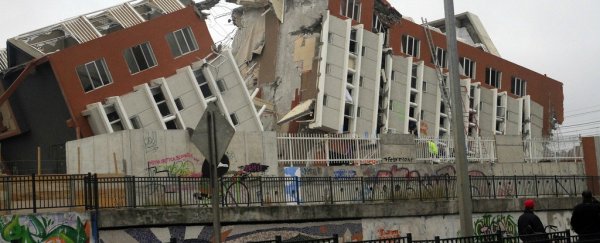Earthquakes happen when there's a sudden release of energy from Earth's outer shell, causing the surface to shake. They're measured on the Richter scale, which basically records what level the tremor was: enough to shake a few tiles off a roof, or sufficient enough to destroy the building altogether.
Earthquakes are a lot harder to monitor than volcanic eruptions, but some techniques are used such as laser beams to detect plate movement, or a seismometer to pick up the vibrations in Earth's crust.
Now, thanks to new research, scientists at the University of Pennsylvania believe they have found a new insight into why earthquakes happen, helping them to predict where they might occur.
Their results were published in Physical Review Letters.
Ageing
It all comes down to a phenomenon called ageing, which looks at the amount of time materials are in contact with one another. The general rule is that the longer materials are in contact, the more force is required to move them.
This resistance to movement is called static friction, and it can build up in a fault - the line where an earthquake occurs - if it sits there for a long time.
"This ageing mechanism is critical in underlying the unstable behaviour of faults that lead to earthquakes," said one of the authors of the study, Robert Carpick, chair of the Department of Mechanical Engineering and Applied Mechanics in Penn's School of Engineering and Applied Science, in a statement.
In general, faults are thin zones of crushed rock separating sections of Earth's crust. When a tremor happens, the rock on one side of the fault slips vertically, horizontally, or at an angle with respect to the other one.
Faults grow stronger with time, which can build stress up to massive levels. This means when they move, a huge amount of energy is released, and you get a powerful earthquake.
"If you didn't have ageing, then the fault would move very easily and so you'd get much smaller earthquakes happening more frequently, or maybe even just smooth motion," said Carpick.
"Ageing leads to the occurrence of infrequent, large earthquakes that can be devastating."
Getting things down to size
The team wanted to understand the friction of rocks from a more physical point of on a smaller scale than ever before.
Researchers have been studying faults and ageing for decades, but their theories and models have been lacking because they have looked at the macroscale, not the nanoscale of the rocks, according to another author of the study, Kaiwen Tian, a graduate student in Penn's School of Arts & Sciences.
To put that in perspective, the macroscale looks at a sample of a material, like a piece of rock, whereas the nanoscale looks at a few atoms.
It was already known from the team's previous research that if materials are in contact for 10 times as long, the friction force required to move them doubles.
In this new study, they put differing amounts of force on the materials, by using an atomic force microscope, to see how the level of bonding varied.
Carpick compared it to putting a block on the floor, letting it sit there a while, then sliding it along and measuring how much force it took to get it to move.
Basically, the friction force goes up over time because more chemical bonds have a chance to form.
"When we push harder, what we're doing is increasing the area of contact between the tip and the sample, causing friction to go up with normal force," Carpick said.
The team are looking at timescales even shorter than one-tenth of a second to better understand how some bonds form easily whereas others take longer.
This could help provide an explanation as to what happens at the beginning of the contact, and maybe one day help predict when and where earthquakes will happen.
"This work gives us more fundamental insights into the mechanism behind this ageing and, in the long term, we think these kinds of insights could help us predict earthquakes and other frictional phenomena better," said Carpick.
This article was originally published by Business Insider.
